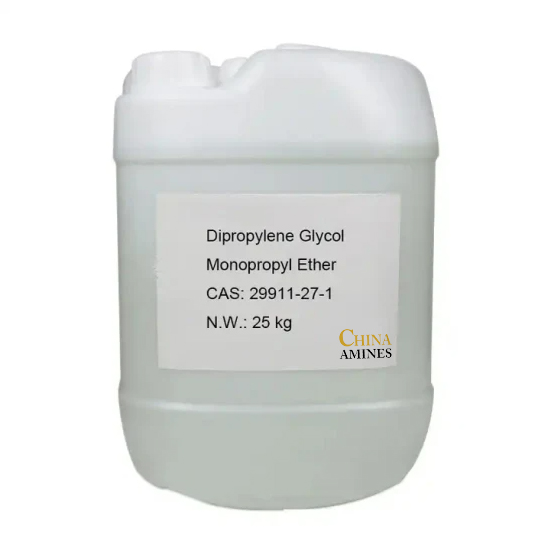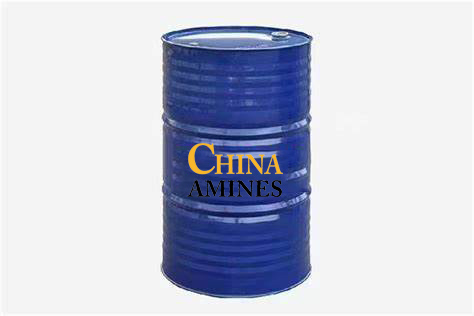1. Chemical Structure and Properties
Molecular Formula: C₉H₂₀O₃
Structural Formula:
CH₃CH₂CH₂O[CH₂CH(CH₃)O]₂H
A branched glycol ether composed of two propylene oxide units linked to a propyl ether group.
Physical Properties:
Appearance: Clear, colorless liquid with a mild, pleasant odor.
Boiling Point: 230–235°C; Density: 0.93–0.95 g/cm³; Vapor Pressure:<0.01 mmHg at 25°C.
Solubility: Partially miscible with water (2% w/w at 25°C); fully miscible with alcohols, esters, and hydrocarbons.
Chemical Properties:
Hydrolysis Stability: Resistant to hydrolysis under neutral and mildly acidic/alkaline conditions.
Thermal Stability: Decomposes above 250°C, releasing propionaldehyde and carbon oxides.
Flammability: Combustible (flash point: ~110°C).
2. Industrial Applications
Coatings & Inks:
High-Boiling Solvent: Enhances flow, leveling, and substrate wetting in automotive and industrial coatings.
Coalescing Agent: Improves film formation in waterborne latex paints.
Cleaning Products:
Heavy-Duty Degreaser: Effective in removing oils, greases, and waxes from machinery and electronics.
Personal Care:
Emollient & Carrier Solvent: Used in cosmetics, lotions, and fragrances for its low volatility and skin compatibility.
Chemical Synthesis:
Intermediate: Produces surfactants and plasticizers via ethoxylation or esterification.
3. Safety and Toxicology
Health Hazards:
Acute Exposure:
Skin Contact: Mild irritation (rabbit skin LD₅₀: >2,000 mg/kg); prolonged exposure may cause defatting.
Inhalation: Low volatility minimizes risk (TLV-TWA: Not established; handle as nuisance vapor).
Ingestion: Low toxicity (oral LD₅₀ rat: >5,000 mg/kg); gastrointestinal discomfort.
Chronic Effects:
Reproductive Toxicity: No teratogenicity observed in OECD 414 studies.
Organ Toxicity: Negligible hepatotoxicity or nephrotoxicity in subchronic rodent studies.
Protection Measures:
PPE: Nitrile gloves, safety goggles, and general ventilation.
Storage: Stable in HDPE containers; store away from strong oxidizers.
4. Environmental and Regulatory Compliance
Environmental Impact:
Biodegradability: Slow (OECD 301F:<30% in 28 days); moderately persistent in soil and water.
Aquatic Toxicity: LC₅₀ (fish, 96h): >100 mg/L; EC₅₀ (daphnia): >50 mg/L.
Bioaccumulation: Low (log Kow: ~1.8).
Regulatory Frameworks:
EU:
REACH: Registered with no SVHC listing; CLP classification Not Hazardous.
USA:
EPA: Exempt from VOC status under 40 CFR 51.100(s)(1); TSCA-listed.
China:
GB 13690-2009: Classified as General Chemical (non-hazardous).
Waste Management:
Incinerate in approved facilities; landfill disposal permitted for small quantities.
5. Case Studies and Application Insights
Case 1: Sustainable Automotive Coatings (BASF, 2023):
Challenge: Reduce VOC emissions in solvent-borne automotive primers without compromising drying performance.
Solution: Dipropylene glycol propyl ether (5% w/w) replaced xylene as a co-solvent.
Result: Achieved 30% lower VOC emissions (ASTM D6886) and maintained adhesion (ASTM D3359).
Case 2: Eco-Friendly Industrial Cleaners (Ecolab, 2022):
Process: Formulated a bio-based degreaser combining dipropylene glycol propyl ether and citrus terpenes.
Impact: Reduced solvent waste by 40% and met EU Ecolabel criteria.
Comparative Analysis:
Dipropylene Glycol Propyl Ether vs. Ethylene Glycol Monobutyl Ether (EGBE):
Pros: Lower toxicity, higher boiling point, and better compatibility with hydrophobic substrates.
Cons: Higher viscosity (~15 mPa·s) limits use in low-viscosity applications.
Dipropylene Glycol Propyl Ether vs. Propylene Glycol Methyl Ether (PGME):
Pros: Improved solvency for resins and reduced skin absorption risks.
Cons: PGME offers faster evaporation for quick-drying formulations.
Specifications:
Dipropylene Glycol Propyl Ether is a clear, low-odor solvent with excellent solvency, high stability, and low evaporation rate, commonly used in paints, coatings, and industrial formulations, available in bulk from China Amines Co.



